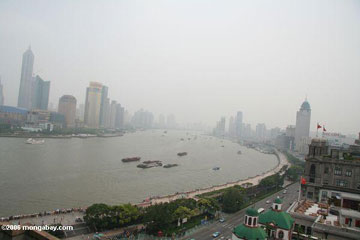China struggles with urban pollution
mongabay.com
October 29, 2007
About 60 percent of Chinese cities still regularly suffer from air pollution and have no centralized sewage treatment facilities, according to a report by China’s environment watchdog, the State Environmental Protection Administration (SEPA).
The report rated air and water pollution as major environmental problems for the China’s 585 cities. It found that air quality met national standards in only 37.6 percent of cities, a drop of 7.3 percentage since for 2005. Thirty-nine cities were classified as having “severe air pollution” with air quality below Grade III.
Seven of the black-listed cities were in the northern province of Shanxi, the country’s largest coal supplier, and seven were in the northeastern province of Liaoning, where many of China’s heavy industries are based.
 Shanghai’s air quality has worsened in 2007 according to SEPA. |
The report also found that the ratio of quality water in the major urban areas — either for drinking or industrial use — had dropped by 7.24 percent. It warned that 200 cities have no centralized sewage management system and 187 cities have no garbage disposal plants.
Nevertheless the report noted some progress in waste water and garbage treatment especially in wealthier cities. Overall 42.5 percent of urban sewage was being treated in the cities surveyed — up from 22.9 percent in 2005 — while 59.5 percent of household garbage was being handled “properly”, compared with less than 20 percent in 2005.
Earlier this year SEPA said that China was likely to miss reduction targets for sulphur dioxide, an acid-rain causing pollutant, for the year
This article is based on a release from SEPA.